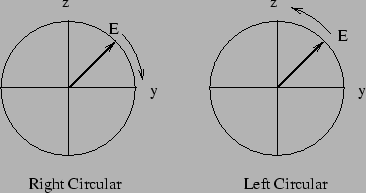



Next: Elliptical polarization
Up: The vector nature of
Previous: Linear polarization
Contents
The polarization of the wave refers to the time evolution of the
electric field vector.
An interesting situation occurs if the same signal is fed to the two
dipoles, but the signal to the z axis is given an extra  phase .
The electric field now is
phase .
The electric field now is
If we now follow the evolution of  at a fixed point, we
see that the tip of the vector
at a fixed point, we
see that the tip of the vector  moves on a circle of radius E
clockwise (when the observer looks towards the source) as shown in Figure
19.3
moves on a circle of radius E
clockwise (when the observer looks towards the source) as shown in Figure
19.3
Figure 8.3:
Circular polarization
 |
We call such a wave right circularly polarized. The electric field
would have rotated in the opposite direction had we applied a phase
lag of . We would then have obtained a left circularly
polarized wave.




Next: Elliptical polarization
Up: The vector nature of
Previous: Linear polarization
Contents
Physics 1st Year
2009-01-06